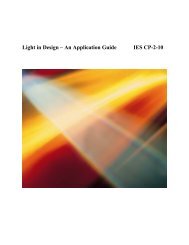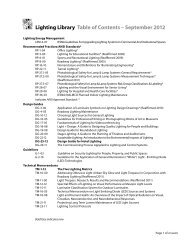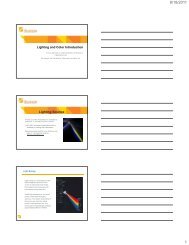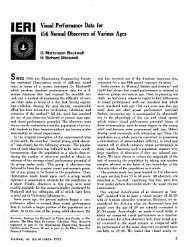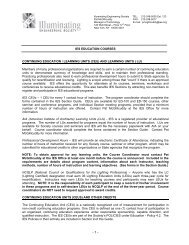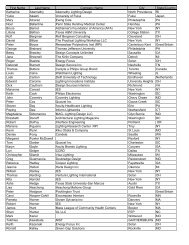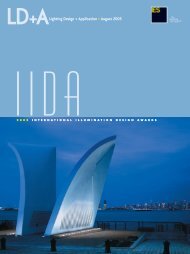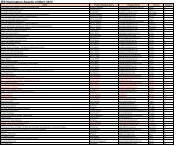Residential Lighting - Illuminating Engineering Society
Residential Lighting - Illuminating Engineering Society
Residential Lighting - Illuminating Engineering Society
Create successful ePaper yourself
Turn your PDF publications into a flip-book with our unique Google optimized e-Paper software.
For many years, we may not<br />
have been looking under all of<br />
the “right rocks” when trying<br />
to link lighting to human performance<br />
and well-being or when trying<br />
to characterize lighting quality. The<br />
lighting quality matrix in Chapter 10<br />
of the IESNA <strong>Lighting</strong> Handbook<br />
covers a wide range of visual criteria<br />
(performance, glare, color, etc.), but<br />
We may not<br />
have been<br />
looking under<br />
all of the<br />
“right rocks”<br />
when trying to<br />
link lighting to<br />
human<br />
performance<br />
and well-being<br />
is that all there is to lighting quality<br />
Based on the rapidly emerging<br />
science of circadian photobiology,<br />
the simple answer must be, no, because<br />
light is not just for vision.<br />
www.iesna.org<br />
Why isn’t light just for vision<br />
In 1980, Al Lewy showed that<br />
bright white light (2500 lux for two<br />
hours during the night between<br />
02:00 and 04:00 hours) suppressed<br />
human melatonin to daytime levels<br />
(Lewy et al., 1980) and later<br />
showed that bright white light<br />
relieved symptoms of seasonal<br />
affective disorder (SAD). These discoveries<br />
were very important<br />
because they stimulated other clinical<br />
research. Eus van Someren (van<br />
Someren et al., 1997) has shown<br />
that exposing Alzheimer’s patients<br />
to bright light during the day and<br />
darkness at night consolidated their<br />
rest/activity patterns, Miller et al.<br />
(1995) showed that cycled light,<br />
instead of continuous light, improved<br />
growth rate of premature infants.<br />
Lewy’s work was also the<br />
stimulus for more basic research.<br />
Badia et al. (1991), Boyce et al.<br />
(1997), and Figueiro et al. (2001)<br />
showed that bright light exposure at<br />
night increased brain activity,<br />
improved cognitive performance,<br />
and subjective alertness, respectively.<br />
Also, epidemiologists are<br />
hypothesizing that light at night may<br />
be associated with increased risk of<br />
certain types of cancer (Davis et al.,<br />
2001; Hansen, 2001; Schernhammer<br />
et al., 2001). In summary, I<br />
have been lecturing about light and<br />
health for a few years now, and it<br />
continues to surprise me how I must<br />
continuously update my lectures to<br />
reflect new and exciting research. It<br />
is now impossible to ignore the fact<br />
that light is not just for vision.<br />
What do we know about circadian<br />
photobiology<br />
Biological rhythms that repeat at<br />
approximately every 24 hours are<br />
called circadian rhythms. These<br />
include cycles such as sleep/wake,<br />
body temperature, hormone production<br />
and alertness (Arendt, 1995).<br />
The human circadian timing is controlled<br />
by the circadian pacemaker,<br />
the biological clock located in the<br />
suprachiasmatic nucleus (SCN) of<br />
the brain. Light is the main input to<br />
synchronize the biological clock to<br />
the solar (24-hour) day (Brainard et<br />
al., 1997). If we are not exposed to<br />
sufficient amount of light of the<br />
right spectrum, for a sufficient<br />
amount of time, and at the right timing,<br />
our biological clock becomes<br />
desynchronized with the solar day<br />
and decrements in physiological<br />
functions, neurobehavioral performance<br />
and sleep usually occur. (It<br />
is important to note, however, that<br />
light is the main, but not the only<br />
synchronizer of the biological clock.<br />
Exercise, social activities, and<br />
scheduled meals have also been<br />
shown to synchronize the clock,<br />
although their impact on circadian<br />
rhythmicity is weaker than light).<br />
It is now widely known that melatonin<br />
is a hormone produced by the<br />
pineal gland at night and under conditions<br />
of darkness. Generally, melatonin<br />
is used as a marker of the circadian<br />
clock. Melatonin is believed<br />
to be the hormone of darkness, the<br />
one that tells the body it is nighttime.<br />
Nocturnal animals, such as<br />
mice will interpret this as being<br />
time to be active; humans, on the<br />
other hand, will interpret as being<br />
time to go to bed.<br />
RESEARCH<br />
RECAP<br />
Why propose a new framework<br />
for lighting practice<br />
There are five basic characteristics<br />
of light: quantity, spectrum, distribution,<br />
timing and duration. The<br />
characteristics that are ideal for<br />
vision are quite different than those<br />
that are maximally effective for the<br />
circadian system. Certainly, we are<br />
years away from a complete understanding<br />
of the impact of light on<br />
circadian regulation, but an initial<br />
framework for the effects of light on<br />
vision and on the circadian system<br />
can be helpful in paving the way to<br />
FPO<br />
Mariana G.<br />
Figueiro,<br />
<strong>Lighting</strong><br />
Research<br />
Center



